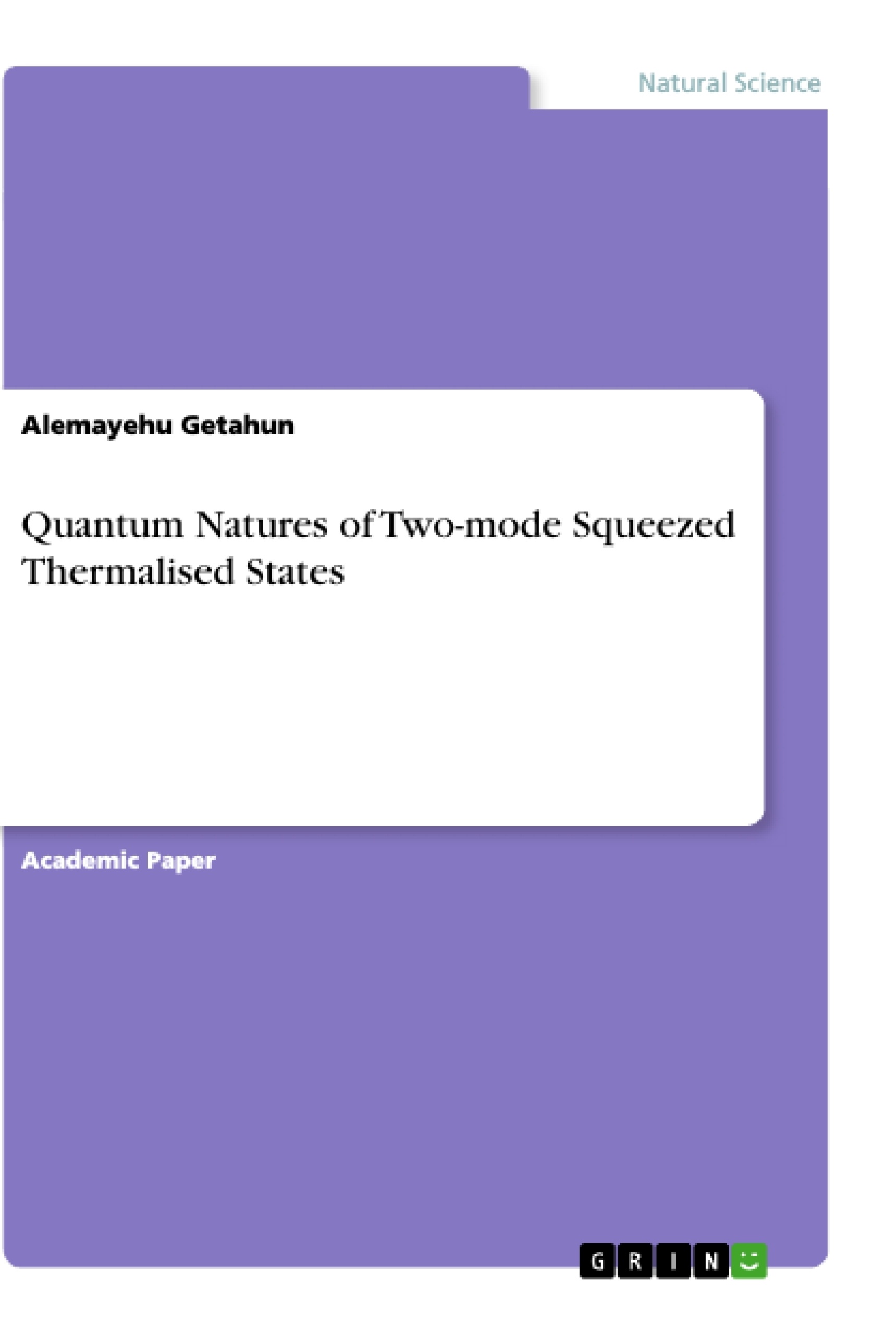Dive into the fascinating realm of quantum optics where the seemingly random dance of photons reveals hidden order and intriguing statistical properties. This groundbreaking study unveils the secrets of two-mode squeezed chaotic states, a peculiar form of light that blends the quantum weirdness of squeezed states with the inherent randomness of thermal light. Using the powerful Q function as a lens, the research meticulously dissects the statistical characteristics of this exotic light source, exploring the intricate relationships between photon number, correlation, and squeezing. Discover how the interplay between squeezing and thermal noise shapes the photon statistics, leading to phenomena like super-Poissonian photon distributions and photon bunching, where photons exhibit a surprising tendency to arrive in clumps. Explore the fundamental quantum properties, unraveling the delicate balance between quantum coherence and thermal fluctuations. The study delves into the mathematical framework underpinning these phenomena, providing a detailed analysis of the density operator, Hamiltonian, and squeezing operator. Through rigorous calculations and insightful interpretations, the work illuminates the subtle nuances of two-mode squeezed thermal light, offering a deeper understanding of the statistical and squeezing properties, and providing invaluable insights into the nonclassical nature of light. From the introduction of thermal light and two-mode squeezed states to the detailed calculation of the Q function and the analysis of photon number sum and difference, every step is carefully explained. Explore the concepts of quadrature squeezing and delve into the world of photon number correlation. This exploration offers not just a theoretical framework, but a practical guide to understanding and manipulating these fascinating quantum states, paving the way for future advancements in quantum technologies. Discover the nature of quantum optics and the statistical properties of light, exploring a world where the rules of classical physics no longer apply. Uncover the secrets of two-mode squeezed chaotic states, and witness the quantum mechanical marvels that arise from the marriage of order and chaos.
Inhaltsverzeichnis (Table of Contents)
- Introduction
- Thermalized two-mode Light
- Two-mode squeezed states
- The Q function
- Photon Statistics
- The mean of the photon number sum and difference
- The variance of the photon number sum and difference
- The second order correlation function
- The quadrature squeezing
- Conclusions
- Reference
Zielsetzung und Themenschwerpunkte (Objectives and Key Themes)
This paper investigates the statistical and squeezing properties of two-mode squeezed chaotic states. The primary objective is to calculate key statistical parameters and analyze the quantum properties of this type of light using the Q function.
- Statistical properties of two-mode squeezed thermal light
- Calculation and interpretation of the Q function for the system
- Analysis of photon number sum and difference
- Investigation of second-order correlation functions
- Examination of quadrature squeezing
Zusammenfassung der Kapitel (Chapter Summaries)
Introduction: This chapter provides a brief overview of the historical context of quantum mechanics and its relevance to the study of quantum optics. It highlights the importance of nonclassical states of light, such as squeezed states, in understanding fundamental aspects of quantum mechanics. The chapter sets the stage for the paper's focus on the statistical and squeezing properties of two-mode squeezed chaotic states, emphasizing the use of the Q function as a crucial analytical tool. The introduction also lays the groundwork by briefly touching on the statistical origins of quantum optics and the importance of understanding the probabilistic nature of quantum systems.
Thermalized two-mode Light: This chapter introduces thermal light, a key element in the study of the two-mode squeezed chaotic states. It defines thermal light and presents the density operator for single-mode and two-mode thermal light, forming the basis for subsequent calculations and analyses. The chapter establishes the mathematical framework necessary for describing the thermal component of the system under investigation. The use of density operators lays the foundation for later combinations with squeezed states.
Two-mode squeezed states: This section delves into the concept of two-mode squeezed states, crucial for understanding the system under investigation. It describes the generation of two-mode squeezed light through a nondegenerate subharmonic system, providing the Hamiltonian for the system and defining the two-mode squeezing operator. It introduces crucial operators and equations that are utilized in later calculations to determine the density operator for the two-mode squeezed chaotic state, combining the squeezed and thermal components. The mathematical derivations presented here are essential for understanding the subsequent sections of the paper.
The Q function: This chapter focuses on the Q function, a tool used to evaluate expectation values of anti-normally ordered operators. The chapter presents the Q function's definition and its application to the system being studied. Detailed mathematical derivations and formulas are provided, leading to the expression for the Q function in terms of relevant parameters. The Q function serves as the central tool for the following analysis of photon statistics and squeezing properties.
Photon Statistics: This chapter delves into the statistical properties of the two-mode squeezed chaotic light using the Q function derived in the previous chapter. It details the calculations for the mean and variance of the photon number sum and difference, providing explanations and interpretations of the results. The use of mathematical techniques and integration are demonstrated. The chapter explores the implications of the calculated variances, relating them to super-Poissonian photon statistics and shedding light on the nature of the system's photon distribution. The detailed analysis establishes a quantitative understanding of the system’s behavior.
Schlüsselwörter (Keywords)
Two-mode squeezed thermal states, Q function, photon statistics, photon number correlation, quadrature squeezing, super-Poissonian statistics, photon bunching.
Häufig gestellte Fragen
What is the main topic of this document?
This document provides an overview of a study analyzing the statistical and squeezing properties of two-mode squeezed chaotic states. It includes a table of contents, objectives, key themes, chapter summaries, and keywords.
What is the Q function, and why is it important in this study?
The Q function is a tool used to evaluate expectation values of anti-normally ordered operators. It's used to analyze the photon statistics and squeezing properties of the two-mode squeezed chaotic light. It's the central analytical tool used in the study.
What are two-mode squeezed chaotic states?
Two-mode squeezed chaotic states are a type of nonclassical light that combines the properties of both squeezed light and thermal light. The study investigates their quantum properties and statistical behavior.
What statistical properties are being analyzed?
The study analyzes the mean and variance of the photon number sum and difference, the second-order correlation function, and quadrature squeezing.
What are the key themes of this study?
The key themes are the statistical properties of two-mode squeezed thermal light, calculation and interpretation of the Q function, analysis of photon number sum and difference, investigation of second-order correlation functions, and examination of quadrature squeezing.
What does the "Thermalized two-mode Light" chapter cover?
This chapter introduces thermal light, defines it, and presents the density operator for single-mode and two-mode thermal light, forming the basis for subsequent calculations and analyses.
What is the focus of the "Two-mode squeezed states" chapter?
This section describes the generation of two-mode squeezed light through a nondegenerate subharmonic system, providing the Hamiltonian for the system and defining the two-mode squeezing operator.
What are some of the keywords associated with this study?
Keywords include: Two-mode squeezed thermal states, Q function, photon statistics, photon number correlation, quadrature squeezing, super-Poissonian statistics, photon bunching.
What is super-Poissonian statistics?
Super-Poissonian statistics describes a photon distribution where the variance of the photon number is greater than the mean, indicating a tendency for photons to arrive in bunches (photon bunching).
- Quote paper
- Alemayehu Getahun (Author), 2019, Quantum Natures of Two-mode Squeezed Thermalised States, Munich, GRIN Verlag, https://www.hausarbeiten.de/document/497403



